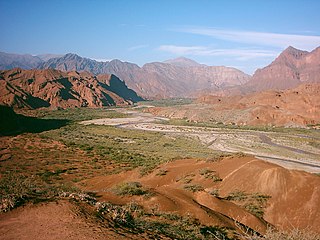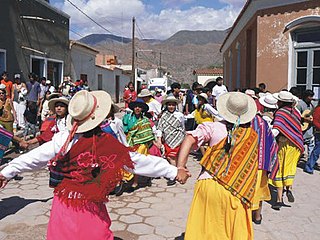The music of Latin America refers to music originating from Latin America, namely the Spanish and Portuguese-speaking regions of the Americas south of the United States. Latin American music also incorporate the indigenous music of Latin America. Due to its highly syncretic nature, Latin American music encompasses a wide variety of styles, including influential genres such as cumbia, bachata, bossa nova, merengue, rumba, salsa, samba, son, and tango. During the 20th century, many styles were influenced by the music of the United States giving rise to genres such as Latin pop, rock, jazz, hip hop, and reggaeton.

The music of Argentina includes a variety of traditional, classical, and popular genres. According to the Harvard Dictionary of Music, Argentina also has "one of the richest art music traditions and perhaps the most active contemporary musical life."

Andean music is a group of styles of music from the Andes region in South America.
Peruvian music is an amalgamation of sounds and styles drawing on Peru's Andean, Spanish, and African roots. Andean influences can perhaps be best heard in wind instruments and the shape of the melodies, while the African influences can be heard in the rhythm and percussion instruments, and European influences can be heard in the harmonies and stringed instruments. Pre-Columbian Andean music was played on drums and string instruments, like the European pipe and tabor tradition. Andean tritonic and pentatonic scales were elaborated during the colonial period into hexatonic, and in some cases, diatonic scales.

Argentina has a vast territory and a variety of climates and microclimates ranging from tundra and polar in the south to the tropical climate in the north, through a vast expanse of temperate climate. Natural wonders include the Aconcagua, the highest mountain in the world outside the Himalayas, the widest river and estuary of the planet, the Iguazú Falls, the Humid Pampas, and the Argentine Sea. Visitors enjoy the culture, customs and Argentine cuisine.

Salta is a province of Argentina, located in the northwest of the country. Neighboring provinces are from the east clockwise Formosa, Chaco, Santiago del Estero, Tucumán and Catamarca. It also surrounds Jujuy. To the north it borders Bolivia and Paraguay and to the west lies Chile.
Música criolla, Peruvian Creole music or canción criolla is a varied genre of Peruvian music that exhibits influences from European, African and Andean music. The genre's name reflects the coastal culture of Peru, and the local evolution of the term criollo, a word originally denoting high-status people of full Spanish ancestry, into a more socially inclusive element of the nation.

The Argentine Northwest is a geographic and historical region of Argentina composed of the provinces of Catamarca, Jujuy, La Rioja, Salta, Santiago del Estero and Tucumán.

The Calchaquí Valley is an area in the northwestern region of Argentina which crosses the provinces of Catamarca, Tucumán, Jujuy and Salta. It is best known for its contrast of colors and its unique geography that ranges from the mountain desert to the subtropical forest.

Jorge Cumbo was an Argentine musician who played the Andean quena flute, combining jazz and Argentine folklore. After early encounters with folklore under his mentor Chango Farías Gomez, and three years at the conservatory, Cumbo discovered the quena flute. After learning the quena from Una Ramos, Cumbo joined Ramos and Jorge Milchberg in the group "Urubamba" with whom he performed from 1970 to 1976. In 1973, "Urubamba" became famous through their cooperation with Paul Simon.
Marcelo Peralta was an Argentine performer, teacher, composer, and arranger who played saxophone, piano, accordion, and the Latin American aerophones.

The Carnavalito is a traditional indigenous dance from the Argentinian Altiplano and puna regions, usually performed during religious festivities. Its current form is an expression of a syncretism between Pre-Columbian and Spanish colonial culture. .

Luis Pereyra is a dancer and choreographer of Tango Argentino and Argentine folk dances.
Peruvian cumbia is a subgenre of chicha that became popular in the coastal cities of Peru, mainly in Lima in the 1960s through the fusion of local versions of the original Colombian genre, traditional highland huayno, and rock music, particularly surf rock and psychedelic rock. The term chicha is more frequently used for the pre-1990s variations of the subgenre.
The Calchaquí or Kalchakí were a tribe of South American Indians of the Diaguita group, now extinct, who formerly occupied northern Argentina. Stone and other remains prove them to have reached a high degree of civilization. Under the leadership of Juan Calchaquí they offered a vigorous resistance to the first Spanish colonists coming from Chile.
Ojos azules, is a "taquirari" registered in 1947 by the Bolivian composer Gilberto Rojas Enriquez. The Peruvian composer Manuel Casazola Huancco was also erroneously attributed as the author of the song. According to investigations about the origin of the song, it was originally known as "Ojos bonitos", a traditional Peruvian huayno from Cuzco. The song remains popular in the repertoire of Andean music groups from Bolivia, Peru, Chile, and Argentina.
Salta Basin or Salta Rift Basin is a sedimentary basin located in the Argentine Northwest. The basin started to accumulate sediments in the Early Cretaceous (Neocomian) and at present it has sedimentary deposits reaching thicknesses of 5,000 metres (16,000 ft). The basin contains seven sub-basins: Tres Cruces, Lomas de Olmedo, Metán, Alemanía, Salfity, El Rey, Sey and Brealito. The basin environment has variously been described as a "foreland rift" and an "intra-continental rift". The basin developed under conditions of extensional tectonics and rift-associated volcanism.

Leda Valladares was an Argentine singer, songwriter, musicologist, folklorist, and poet. Born in San Miguel de Tucumán in northern Argentina, she grew up surrounded by both classical European music and the folk music of the Amerindian people living in the area. From a young age she studied piano and in her teens began a band with her brother that explored folk music, jazz, and blues. She published works of poetry throughout her life. Although she began her university studies at the National University of Tucumán as an English major, after a year she changed course and studied philosophy and education, graduating in 1948. Her schooling was interrupted by a foray into the study of music at the Academy of Fine Art and in independent research among those who performed traditional folk music.

Micaela Chauque is a Qulla Argentine composer, dancer, coplista and flautist, specializing in the quena and siku. She has been lauded as one of the best interpreters of Andean music in Argentina. She is also a music teacher and luthier.

The folkloric music of Argentina traces its roots to the multiplicity of native indigenous cultures. It was shaped by four major historical-cultural events: Spanish colonization and forced African immigration caused by the slave trade during the Spanish domination ; the large wave of European immigration (1880–1950) and the large-scale internal migration (1930–1980).












